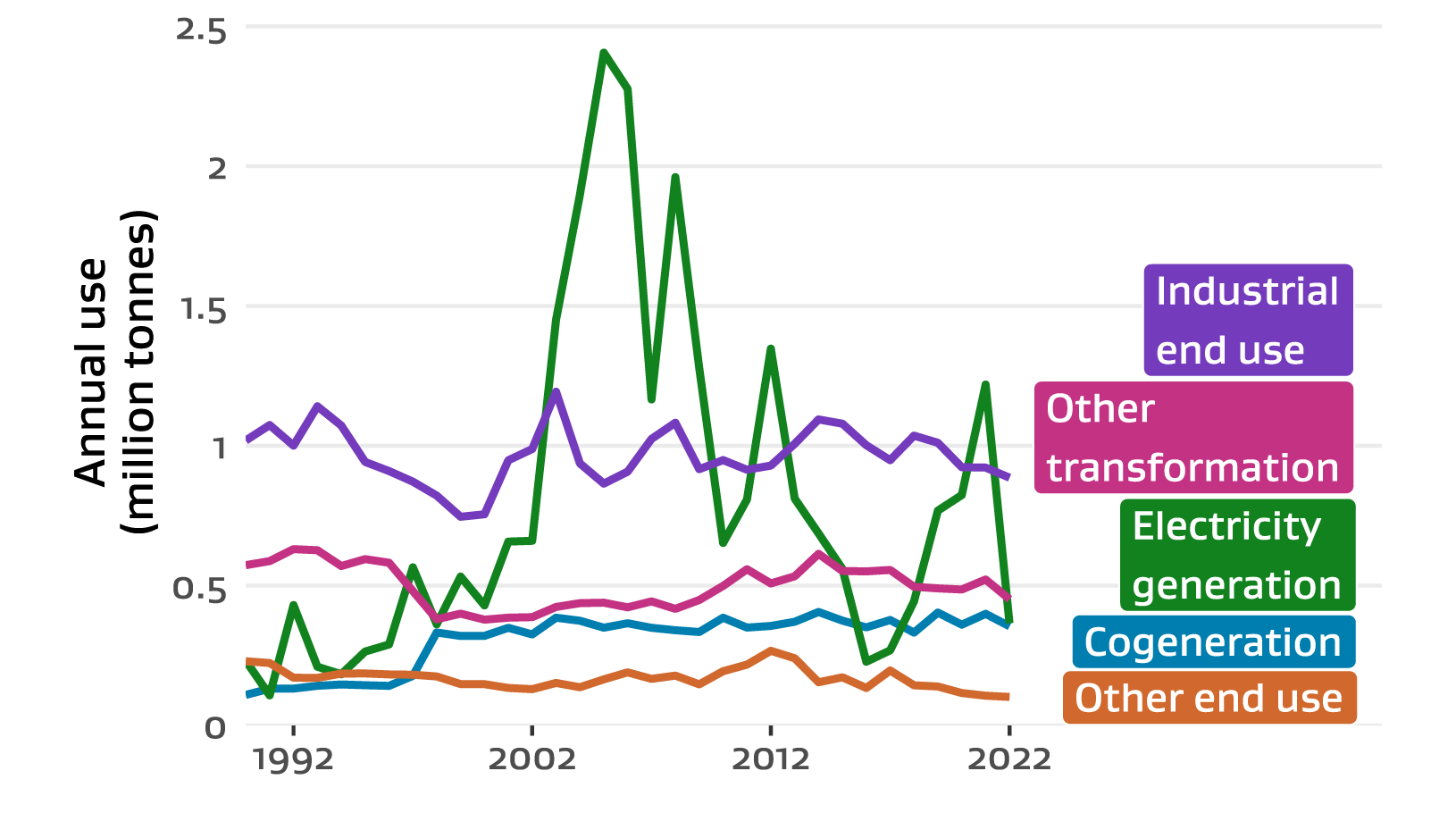Coal
New Zealand has extensive coal resources. Our estimated in-ground resources are over 15 billion tonnes, although 80% of this is lignite in the South Island. Sub-bituminous and bituminous in-ground resources are around 4 billion tonnes, but economic reserves are much smaller.
On this page
New Zealand's coal industry can be divided into 3 distinct geological areas.
- In the North Island, coal production is centred in the Waikato region where large coalfields like Maramarua and Rotowaro produce sub-bituminous coal. This coal is excellent for heating and electricity generation, although its quality is generally not high enough for it to be used in the production of iron and steel. The main consumers of this coal are Genesis' Huntly Power Station and the Glenbrook steel mill. Unlike most steel mills around the world, the Glenbrook mill can use sub-bituminous coal due to the unique processes used at the facility.
- Coal extracted on the West Coast of the South Island is mostly bituminous coal, along with some sub-bituminous. The bituminous coal is generally exported for steelmaking.
- The rest of the South Island tends to produce either sub-bituminous coal, or the even lower-energy lignite.
14 mines were operating in New Zealand at the end of 2022 compared to 18 at the end of 2020. Most of the imported coal is sub-bituminous coal, used for electricity generation and steel production.
Additional background information on New Zealand's coal industry is available at:
Coal(external link) — New Zealand Petroleum & Minerals
Coal at a glance
Production
Consumption
Imports
Exports
- Coal use fell by over 30% in 2022
- New Zealand is a net exporter of coal again, after becoming an importer for the first time in 2021
- We produced 2.6 million tonnes of coal in 2022, the lowest in 33 years.
The amount of imported coal has fallen back below export levels
The amount of imported coal more than halved in 2022 (Figure G.1). In 2021, the amount of imported thermal coal spiked by 71% to the highest level on record and exceeding exports for the first time on record. This was driven by demand for electricity generation due to low hydro levels in the first part of the year. The decline in imported coal in 2022 was mostly driven by improved hydro generation, reducing the need for thermal back-up. Subsequently, coal stocks remained high throughout the year.
The amount of exported coal increased slightly in 2022, driven mostly by increased amounts of West Coast coking coal exported. New Zealand mostly exports coking coal, with smaller amounts of thermal and specialist coals. New Zealand coal is exported to countries such as Japan, India, China, South Korea, and Australia.
Figure G.1 New Zealand’s export and import of coal, from 1990 to 2022

Text description of figure G.1
In 2022, coal production was the lowest in 33 years
New Zealand’s total coal production in 2022 was 2.6 million tonnes (66.0 PJ), a decrease of 8% from 2021. This was the lowest level of production in 33 years. Production fell across all ranks of coal (Figure G.2).
Over the last few years, several mines have stopped operating, including the Escarpment and New Creek mines on the West Coast, Ohai mine in Southland, and Malvern Hills mine in Canterbury.
Sub-bituminous coal production decreased by 15% nationally. North Island mines decreased production by 17% and South Island mines decreased production by 11%. Bituminous coal production decreased by 2.1% compared to 2021, while lignite production decreased by 3%.
Figure G.2 New Zealand’s coal production by rank of coal, from 1990 to 2022

Text description of figure G.2
Coal use has dropped because of lower levels of both consumption and transformation
Total use of coal in New Zealand fell by over 30% in 2022. This was because of drops in both consumption and transformation use.
New Zealand’s total consumption (excluding transformation) of coal in 2022 decreased by 4% compared to 2021. This was the fourth year in a row that demand reduced, resulting in the lowest level of consumption in 22 years. The decrease in consumption was led by the industrial sector — the dominant user of coal in New Zealand (Figure G.3).
Coal use for transformation also dropped in 2022. Coal use for primary electricity generation decreased 70% from 2021, with cogeneration and other transformation processes (including iron and steel use) dropping 11% and 14% respectively. The decrease in coal use for electricity generation was mainly due to improved hydrological conditions in 2022, compared with the dry hydrological year and decreased natural gas production in 2021. There is more detailed information about improved hydro conditions in the electricity section:
Changes in coal use in the North Island are heavily influenced by the Huntly Power Station. This is the only coal-fired power plant in New Zealand and is important for security of electricity supply. Electricity from the Huntly Power Station may be needed in dry years and periods of limited natural gas supply to meet our requirements for winter energy and peak demand.
Figure G.3 New Zealand’s coal use (consumption and transformation) by sector

Text description of figure G.3
Government programmes are starting to impact coal use
Coal consumption is dominated by the industrial sector, which has been targeted by Government policies designed to reduce emissions.
Government Investment in Decarbonising Industry (GIDI) fund
Several projects initiated through the Government Investment in Decarbonising Industry (GIDI) fund are starting to impact the industrial use of coal. There is more detailed information about GIDI in the renewables section:
The Government Investment in Decarbonising Industry (GIDI) fund
Industrial conversion of coal to alternative fuels include the following examples.
- Fonterra’s Te Awamutu site started using biomass instead of coal to operate in 2022.
- Fonterra’s Stirling site started the conversion to biomass in 2022 and this was commissioned in April 2023.
- Fonterra’s Hautapu and Waitoa sites are converting to biomass in 2023 with commissioning expected in 2024.
- Open Country Dairy commissioned an electric boiler at the Awarua site in 2021.
- Open Country Dairy is converting its Waharoa site to biomass.
- The Washdyke industrial centre converted to biomass in 2022.
- Affco and Silver Fern Farms have converted a number of meat works from coal to electricity.
State sector decarbonisation fund
The state sector decarbonisation fund (SSDF) is also starting to impact coal use across the public sector. Progress and recent developments include the following examples.
- In May 2023, the Government announced investments through the SSDF to support the removal of all state-owned coal boilers from public hospitals and tertiary institutions by 2025.
- Most coal-fired boilers in schools have already been replaced with the remainder tracking to be removed by 2025.
- Christchurch Hospital switched from coal to new biomass boilers in February 2023.
For more information about the SSDF, visit:
State sector decarbonisation fund(external link) — Energy Efficiency and Conservation Authority (EECA)

